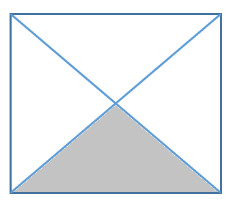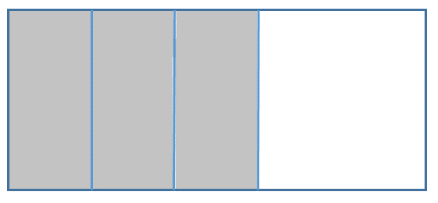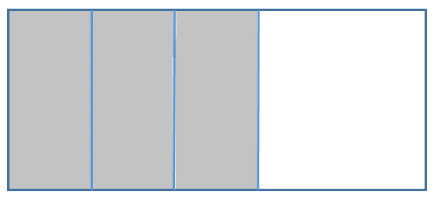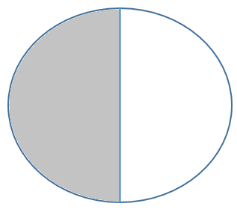
Which model is shaded such that the fraction it represents is \[\dfrac{3}{6}\]








Answer
575.7k+ views
Hint:
Now we want to find out the shaded region which represents a fraction $\dfrac{3}{6}$ . First we will bring this fraction in the lowest form. Then we will check each figure, To find what fraction the shaded portion represents we will use the formula $\dfrac{\text{number of shaded parts}}{\text{total number of parts}}$ . Hence we can calculate the fraction for each figure.
Complete step by step answer:
Now first let us check the given fraction. The given fraction is $\dfrac{3}{6}$ . Now we want to convert the fraction in its lowest form. A fraction $\dfrac{p}{q}$ is said to be in lowest form when p and q are co-primes or such that they cannot divide each other and q not equal to 0.
Hence if we divide the numerator and denominator of given fraction $\dfrac{3}{6}$ by 3 we get $\dfrac{1}{2}$
Hence the lowest form of the given fraction is $\dfrac{1}{2}$
Now consider the first figure given

Now in this figure the square is divided in 4 equal parts and among them 1 is shaded.
Now the fraction it represents is given by $\dfrac{\text{number of shaded parts}}{\text{number of total parts}}$
Hence the shaded portion represents $\dfrac{1}{4}$
Now let us consider the second figure

Now in this figure we have that the rectangle is divided in 8 equal parts and among them 3 parts are shaded.
Now the fraction it represents is given by $\dfrac{\text{number of shaded parts}}{\text{number of total parts}}$
Hence the shaded portion represents $\dfrac{3}{8}$
Now let us consider the third figure

Now we can see that the rectangle is not divided into equal parts hence we cannot calculate the fraction it represents.
Now let us consider the next figure

Now in this figure, we can see that the circle is divided in two equal parts and 1 part is shaded.
Now the fraction it represents is given by $\dfrac{\text{number of shaded parts}}{\text{number of total parts}}$
Hence the shaded portion represents $\dfrac{1}{2}$
Hence we have the fourth figure is the one which represents the fraction $\dfrac{1}{2}$ and hence $\dfrac{3}{6}$ .
Note:
Note that when checking the fraction the shaded portion represents we use the formula $\dfrac{\text{number of shaded parts}}{\text{number of total parts}}$ but before using this we must check if the figure is divided in equal parts if it is not divided in equal parts then we cannot use this formula.
Now we want to find out the shaded region which represents a fraction $\dfrac{3}{6}$ . First we will bring this fraction in the lowest form. Then we will check each figure, To find what fraction the shaded portion represents we will use the formula $\dfrac{\text{number of shaded parts}}{\text{total number of parts}}$ . Hence we can calculate the fraction for each figure.
Complete step by step answer:
Now first let us check the given fraction. The given fraction is $\dfrac{3}{6}$ . Now we want to convert the fraction in its lowest form. A fraction $\dfrac{p}{q}$ is said to be in lowest form when p and q are co-primes or such that they cannot divide each other and q not equal to 0.
Hence if we divide the numerator and denominator of given fraction $\dfrac{3}{6}$ by 3 we get $\dfrac{1}{2}$
Hence the lowest form of the given fraction is $\dfrac{1}{2}$
Now consider the first figure given

Now in this figure the square is divided in 4 equal parts and among them 1 is shaded.
Now the fraction it represents is given by $\dfrac{\text{number of shaded parts}}{\text{number of total parts}}$
Hence the shaded portion represents $\dfrac{1}{4}$
Now let us consider the second figure

Now in this figure we have that the rectangle is divided in 8 equal parts and among them 3 parts are shaded.
Now the fraction it represents is given by $\dfrac{\text{number of shaded parts}}{\text{number of total parts}}$
Hence the shaded portion represents $\dfrac{3}{8}$
Now let us consider the third figure

Now we can see that the rectangle is not divided into equal parts hence we cannot calculate the fraction it represents.
Now let us consider the next figure

Now in this figure, we can see that the circle is divided in two equal parts and 1 part is shaded.
Now the fraction it represents is given by $\dfrac{\text{number of shaded parts}}{\text{number of total parts}}$
Hence the shaded portion represents $\dfrac{1}{2}$
Hence we have the fourth figure is the one which represents the fraction $\dfrac{1}{2}$ and hence $\dfrac{3}{6}$ .
Note:
Note that when checking the fraction the shaded portion represents we use the formula $\dfrac{\text{number of shaded parts}}{\text{number of total parts}}$ but before using this we must check if the figure is divided in equal parts if it is not divided in equal parts then we cannot use this formula.
Recently Updated Pages
Two men on either side of the cliff 90m height observe class 10 maths CBSE

What happens to glucose which enters nephron along class 10 biology CBSE

Cutting of the Chinese melon means A The business and class 10 social science CBSE

Write a dialogue with at least ten utterances between class 10 english CBSE

Show an aquatic food chain using the following organisms class 10 biology CBSE

A circle is inscribed in an equilateral triangle and class 10 maths CBSE

Trending doubts
The shortest day of the year in India

Why is there a time difference of about 5 hours between class 10 social science CBSE

Write a letter to the principal requesting him to grant class 10 english CBSE

What is the median of the first 10 natural numbers class 10 maths CBSE

The Equation xxx + 2 is Satisfied when x is Equal to Class 10 Maths

What is the missing number in the sequence 259142027 class 10 maths CBSE




